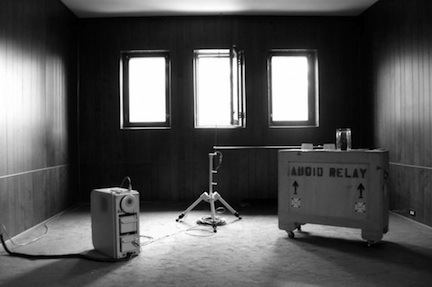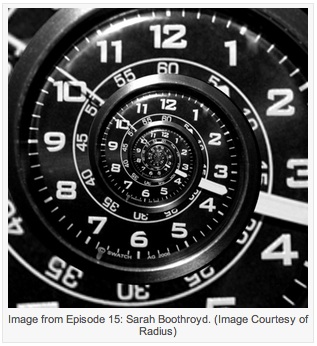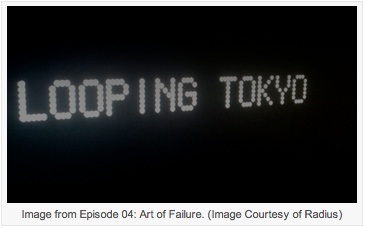| « Miami Nice: A Tale of Good Golden Girls Gone Bad | Art Around Town » |
Sixty Inches from Center Thu Jan 24 2013
Radius: A Sonic Lens
by Kate Korroch

 Art platforms that strive to break away from the traditional "white cube" frequently consist of a new kind of physical space transformed into a gallery-like setting. Using a radio broadcasting system, Radius transcends material space and creates an entirely new kind of art platform. Artists occupy the space for two weeks or one month like an on-air residency. Through their time on Radius, artists work with Director Jeff Kolar and Editor Meredith Kooi to schedule broadcasts that experiment with notions of sound.
Art platforms that strive to break away from the traditional "white cube" frequently consist of a new kind of physical space transformed into a gallery-like setting. Using a radio broadcasting system, Radius transcends material space and creates an entirely new kind of art platform. Artists occupy the space for two weeks or one month like an on-air residency. Through their time on Radius, artists work with Director Jeff Kolar and Editor Meredith Kooi to schedule broadcasts that experiment with notions of sound.
This January marks Radius's two-year anniversary. Since its conception, Radius has aired 34 episodes created by 71 individual artists and have released 144 broadcasts on their station 88.9-FM, which is roughly 25 hours of audio. They've had three special series, two FM re-broadcast networks (soon that will be three with an online station added to the mix), two exhibition installations, a booklet, a newsprint, and a live concert. In their two years Radius has been prolific to say the least.
 When I spoke to Jeff Kolar about Radius and the impact of using radio as an art platform he aptly emphasized the project's unique public-awareness component. Radio is not only the entertainment unit of the past, but it is also a warning system used when there is a moment of public distress--an escaped prisoner or a tornado hurdling forward about to strike. You know the sound, the loud, twangy pitch that signals a warning. It's chilling. With that in mind, consider Radius's very first episode; Michael Woody presented a 09:16 minute long piece called Number Stations 1 and 2. (Number stations are described here but are more or less the radio space between the AM and FM dials.) On the Radius website Woody's work is described as "a reflection of secrecy, control, and power." Woody works in variety of art forms that include painting, photography, video, and sound. In Number Stations 1 and 2 there is a static background sprinkled with low double-beeps, and a man's skewed voice is aired explaining what to do in the case of a bear attack. Alarming phrases are directed at the listener, such as, "Your face is exposed, you're going to lose half of your face, it's called degloving" and "Spread your legs so that you don't get rolled over by the bear." It is a matter-of-fact discussion of mauling prevention. Imagine hearing that on the radio. The short description is replayed multiple times in a loop that only alters slightly.
When I spoke to Jeff Kolar about Radius and the impact of using radio as an art platform he aptly emphasized the project's unique public-awareness component. Radio is not only the entertainment unit of the past, but it is also a warning system used when there is a moment of public distress--an escaped prisoner or a tornado hurdling forward about to strike. You know the sound, the loud, twangy pitch that signals a warning. It's chilling. With that in mind, consider Radius's very first episode; Michael Woody presented a 09:16 minute long piece called Number Stations 1 and 2. (Number stations are described here but are more or less the radio space between the AM and FM dials.) On the Radius website Woody's work is described as "a reflection of secrecy, control, and power." Woody works in variety of art forms that include painting, photography, video, and sound. In Number Stations 1 and 2 there is a static background sprinkled with low double-beeps, and a man's skewed voice is aired explaining what to do in the case of a bear attack. Alarming phrases are directed at the listener, such as, "Your face is exposed, you're going to lose half of your face, it's called degloving" and "Spread your legs so that you don't get rolled over by the bear." It is a matter-of-fact discussion of mauling prevention. Imagine hearing that on the radio. The short description is replayed multiple times in a loop that only alters slightly.
 Some of the sound pieces on Radius have a more melodious tone. Episode 16, My Hard Drive is Experiencing Some Strange Noises by Paris native Gregory Chatonsky, is one of the more musical pieces on Radius. According to the website, Chatonsky's work "speaks to the relationship between technologies and affectivity, flows that define our time to create new forms of fiction." At first it sounds like a far-off orchestra tuning its instruments for a performance. In the background there is a fast flap-like rhythm--the pulse of helicopter wings comes to mind. The layer of sound that guides this work calls to mind a bundle of electric sounds in a jar being gently shaken. This work sets a very specific tone. In this instance, the sounds repeat over and over again in a loop, but at first the recurrence is not noticeable. It is not tiringly repetitive. Instead, the mellow pace and the subtle layers are allowed to unfold, to be gently pealed away and understood.
Some of the sound pieces on Radius have a more melodious tone. Episode 16, My Hard Drive is Experiencing Some Strange Noises by Paris native Gregory Chatonsky, is one of the more musical pieces on Radius. According to the website, Chatonsky's work "speaks to the relationship between technologies and affectivity, flows that define our time to create new forms of fiction." At first it sounds like a far-off orchestra tuning its instruments for a performance. In the background there is a fast flap-like rhythm--the pulse of helicopter wings comes to mind. The layer of sound that guides this work calls to mind a bundle of electric sounds in a jar being gently shaken. This work sets a very specific tone. In this instance, the sounds repeat over and over again in a loop, but at first the recurrence is not noticeable. It is not tiringly repetitive. Instead, the mellow pace and the subtle layers are allowed to unfold, to be gently pealed away and understood.
With its submission requirements, Radius offers a unique opportunity for its various types of artists and, simultaneously, a variety of entry points into the work for the audience. Along with the sound work, each artist that contributes work to Radius must offer a visual component and a written component. The visual component is an opportunity for non-visual artists to present their work in a new format. During our conversation, Kolar said that it is very interesting to watch the non-visual artists break the traditional rules of design that a trained visual artist might follow.
 Though based in Chicago, Radius inadvertently became an international art platform. The small community of sound artists network and share artwork on blogs such as Disquiet, free103point9, Modisti, Networked Performance, Networked Music Review, Le Perce-oreilles, and Cultural Flow. Only a handful of the artists that have contributed to Radius are from Chicago. Episode 25, Cultural Morphing, was created by a group of twelve artists for a project in which the artists traveled by train from Vienna, Austria to Shanghai, China. At various points along the journey each artist stopped in a town and recorded sounds. The broadcast for Radius is the score from when the artists reconvened at a dinner in China and shared their sounds. The artwork is an image of the table at the meal. To mark transition through this work a voice, a type of "Mrs. Garmin", interjects in each scene with what sounds like the name of a city. Sometimes the voice is clearly discernable, though not necessarily in English, and other times the voice is layered under other sounds. Between the Mrs. Garmin markers there are sounds of everyday life in the various stops between Vienna and Shanghai. Bells, horns, chopping, rhythms, traffic, muffled voices, chaos, and calm; none of the sounds seem like they are from a private space, yet they are an intimate invasion into public life, detecting and amplifying the sounds that we do not usually hear because our focus is elsewhere as we walk down a street. What kind of lens does this work provides for viewing culture? While listening it is difficult to distinguish between the plethora of lenses--artist's lens, culture lens, city lens--they become so indistinguishable that they are muddled together. Not in an uninteresting way, but in a way that blurs the cultures into one heap of sounds and experiences.
Though based in Chicago, Radius inadvertently became an international art platform. The small community of sound artists network and share artwork on blogs such as Disquiet, free103point9, Modisti, Networked Performance, Networked Music Review, Le Perce-oreilles, and Cultural Flow. Only a handful of the artists that have contributed to Radius are from Chicago. Episode 25, Cultural Morphing, was created by a group of twelve artists for a project in which the artists traveled by train from Vienna, Austria to Shanghai, China. At various points along the journey each artist stopped in a town and recorded sounds. The broadcast for Radius is the score from when the artists reconvened at a dinner in China and shared their sounds. The artwork is an image of the table at the meal. To mark transition through this work a voice, a type of "Mrs. Garmin", interjects in each scene with what sounds like the name of a city. Sometimes the voice is clearly discernable, though not necessarily in English, and other times the voice is layered under other sounds. Between the Mrs. Garmin markers there are sounds of everyday life in the various stops between Vienna and Shanghai. Bells, horns, chopping, rhythms, traffic, muffled voices, chaos, and calm; none of the sounds seem like they are from a private space, yet they are an intimate invasion into public life, detecting and amplifying the sounds that we do not usually hear because our focus is elsewhere as we walk down a street. What kind of lens does this work provides for viewing culture? While listening it is difficult to distinguish between the plethora of lenses--artist's lens, culture lens, city lens--they become so indistinguishable that they are muddled together. Not in an uninteresting way, but in a way that blurs the cultures into one heap of sounds and experiences.
 Throughout a good portion of this listening experience I stared at my computer screen--the place where I released this experience onto my ears with a click of a button. The moving component, the visualization of the sound wave, became an optical guide, map-like, for my listening experience. Consider the contours of the artists' path compared to the contours of the sound each artist provides for the score. Radius uses the visualization of the sound wave as another entry point into the piece. In one way, it can be seen as a mapping device--making something non-visual visual.
Throughout a good portion of this listening experience I stared at my computer screen--the place where I released this experience onto my ears with a click of a button. The moving component, the visualization of the sound wave, became an optical guide, map-like, for my listening experience. Consider the contours of the artists' path compared to the contours of the sound each artist provides for the score. Radius uses the visualization of the sound wave as another entry point into the piece. In one way, it can be seen as a mapping device--making something non-visual visual.
Radius is usually based out of Chicago's Pilsen neighborhood, with a roughly eight-block broadcasting radius, but the transmitter can be solar powered and therefore used anywhere. Last fall Radius participated in Home: Public or Private at 6018 North on the other side of Chicago. Out of the small smattering of works I experienced to write this piece, Episode 31, Joseph Kramer's piece Porous Notion: Index Fragments and Interpretations, was the most challenging. The concept is fascinating and melds with the mission of the exhibition in which it was presented. That being said, stripped down to just the sound, not considering the concept, title, or imagery, the 30-minute piece demands a specific kind of focus and understanding. Through the duration of the piece incredibly minor variation become exciting and leave some listeners befuddled by their reaction. Navigating the nuances of Kramer's sounds one becomes desperate for something to follow, to guide the listening experience. The work is incredibly subtle and nuanced. When I heard the piece at 6018 North I thought something was wrong with the transmitter, but it was, in fact, playing properly.
 When you visit Radius's website you will notice that the entire site has been designed in black and white. This was not only an aesthetic choice but also a conscious parallel to the radio format. Kolar explained to me that the FM spectrum, in which Radius is broadcasted, is a mono signal opposed to stereo. A stereo file would be played from two channels, the left and right, to mimic the stereo field, but Radius's FM broadcast cannot reproduce stereo audio signals so the sound is in mono format. The visual equivalent to that is taking away color-hence the black and white.
When you visit Radius's website you will notice that the entire site has been designed in black and white. This was not only an aesthetic choice but also a conscious parallel to the radio format. Kolar explained to me that the FM spectrum, in which Radius is broadcasted, is a mono signal opposed to stereo. A stereo file would be played from two channels, the left and right, to mimic the stereo field, but Radius's FM broadcast cannot reproduce stereo audio signals so the sound is in mono format. The visual equivalent to that is taking away color-hence the black and white.
Though Radius offers a variety of entry points into each piece, Kolar emphasizes the importance of hearing the work in the way it is originally intended--in the eight-block radius on the radio. This month there are five broadcasts of Episode 35, Hugo Paquete's Radial Transference.
Click here to view details about that and Radius's upcoming broadcasts and events.
This article was originally published at Sixty Inches from Center on January 14. We are featuring it as part of our content exchange program with them.








